
Technology should enhance productivity, not hinder it. What makes SpaceClaim special is that it takes the complication out of CAD modeling.
SpaceClaim is a great alternative solution for CAD modeling. It can get the job done—faster, simpler, and at a more affordable price when compared to feature-based CAD software which can be expensive, rigid, and require a CAD specialist to run the program. SpaceClaim is a direct modeler that gives any engineer, designer, and machinist the power and flexibility to edit, repair, and create any geometry with ease—without worrying about where the file comes from and without any specialized training.
The new SpaceClaim 2017 released earlier this year is full of new features and enhancements to make CAD modeling even more intuitive for creating and editing 3D models quickly.
From large changes to behind the scenes enhancements, the new version will speed up your workflow and create better models for design, reverse engineering, manufacturing, additive manufacturing (or 3D printing), and simulation.
Let’s take a look at some of these new features.
3D Modeling Improvements
Minimal Distortion for Unfolding of Surfaces
The Unfold feature is especially useful for sheet metal designs. When you design a model, like a stamp sheet metal part, it would be challenging to unfold because it’s distorted as it’s manufactured with all the different curvatures.

With this new feature, SpaceClaim can now flatten multiple connected faces of complex sheet metals or modeling surface skins to a 2D profile surface with a single click. The software will first minimize any changes to the overall area of the set of faces. Secondly, it will minimize the changes to the length of edges, essentially the perimeter of the model and its geometry features (ie. holes).
SpaceClaim 2017 also added new bend annotations. When used with the Unfold feature, it gives a better graphical display of information to your manufacturer for bending the sheet metals to make sure your product is bent to the right bend angle and direction.

Volumetric Sweep
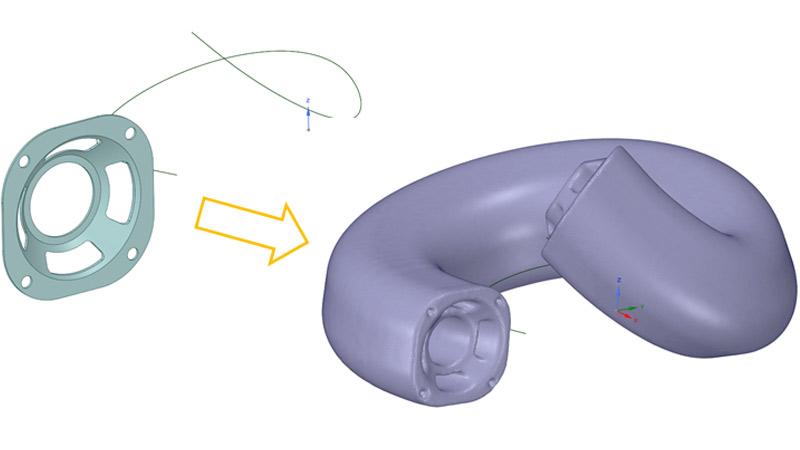
This new functionality can take a solid body and sweep it along an arbitrary path. The result is a faceted body that is useful for creating and visualizing motion paths or envelopes, or for creating cuts from the path of a moving tool bit in machining operations.
Stopped Chamfers
This new feature provides the ability to have chamfers stop at a given distance along an edge. When you add chamfers to a model, you now have control options on either ends of the edge.
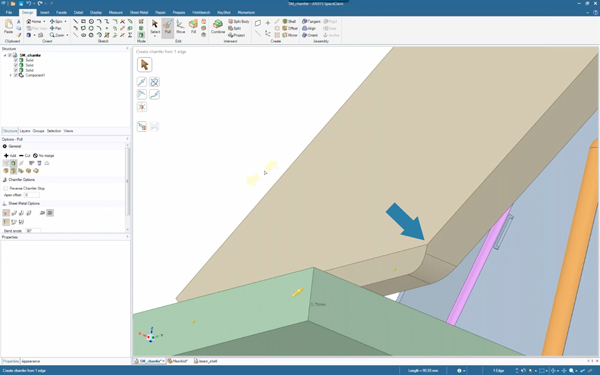
Previous version of SpaceClaim: Chamfers is applied to the entire selected geometry.

SpaceClaim 2017: More options are available to change chamfers the way you want. This is especially useful for architectural applications and welds for bevels.
Additive Manufacturing Improvements
Produce Faceted Models with Lattice Structures

Lattice structures are difficult to manufacture using traditional manufacturing processes such as casting. However, with the rise of additive manufacturing, more and more mechanical designers are taking advantage of building parts with lattice structures as they produce lighter and stronger parts. They are compelling to use for manufacturing better parts built for rigidity with lower material costs.
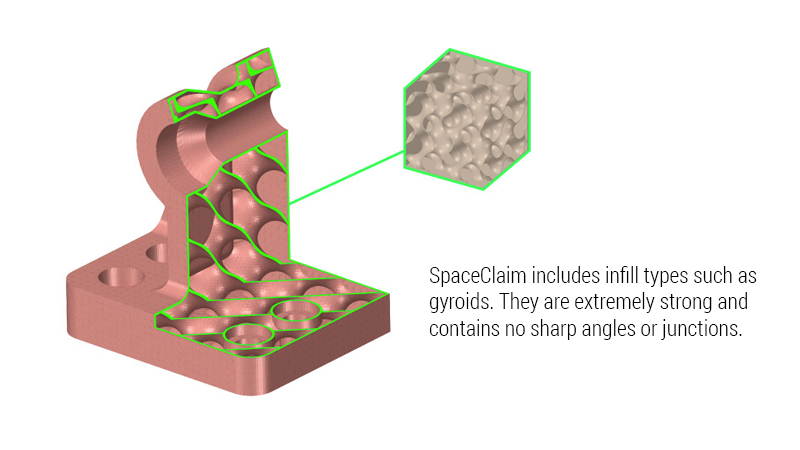
With SpaceClaim 2017, you can shell out any part to a specified thickness to remove the material on the inside and to replace it with an infill of lattice structure. Different lattice patterns are available to choose from depending on applications, the different types of forces and stresses needed for the part. The result is a faceted model ready for additive manufacturing.
Improved Selection Tools
New slider bar tool provides the ability to do more precise selection on faceted models. Sliding the bar allows you to select more facets based on angles. This is extremely helpful because it selects exactly what you want instead of using the static tolerance value. It makes selection a lot more easier.
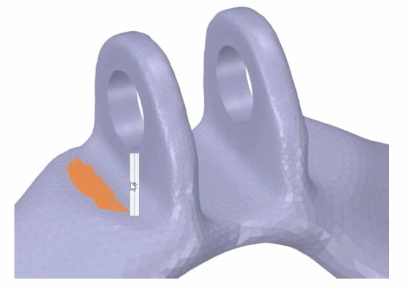
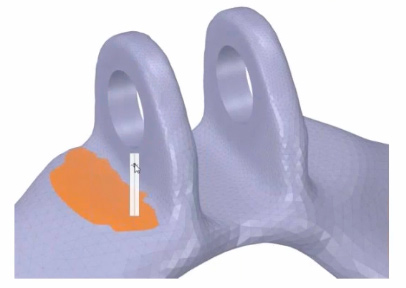
New Analysis Tools
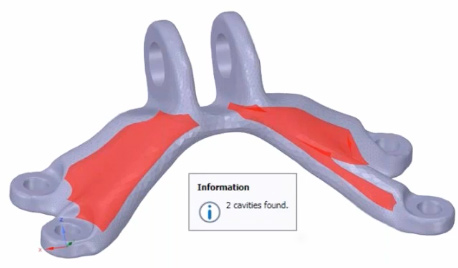
SpaceClaim 2017 has new inspection tools to detect issues prior to printing to ensure there are no problems including cavities errors, overhang detection, thickness improvements, and sharp edges. You can use these tools on solid models and on STL files after you converted them.
Other Notable New Features
Dynamically Move Through the Model with Fly Through View

Very often, SpaceClaim users are modeling complex assemblies where they want to visualize the components of their designs from the inside. Previously prior to this version, SpaceClaim gives a camera perspective from the outside of the part or assembly, where you are looking at the model from far away.
With this new feature, you can change the way you render a scene in SpaceClaim and you can look at things from any vantage point from inside the assembly. You can display and manipulate the camera position to control the field of view (how much you can see) and angle you want to see.
This new feature provides users with a new perspective to design and concept modeling. For example, users now have the ability to look at a 3D model of a building from different perspectives for architectural design—not just from the outside, but from the inside as well.
Scripting

Scripting gives users the ability to automate your modeling, for repetitive tasks or for creating custom geometry.
SpaceClaim 2017 has now expanded the available commands for use in macro-like recording feature. You can now perform a wider array of edits on a model, and SpaceClaim will record the necessary script. The data captured is in the Python language, so you don’t need not be proficient in scripting code or programming in order to use it.
Scripts can be replayed on imported versions of a model. You can record the initial changes to a version of a model, then replay those same changes to a later version of the model. SpaceClaim will recognize the ID’s of faces, bodies and other characteristics, and will intelligently apply scripted changes to later versions of any file. This improvement will reduce your remodeling time as you can capture your changes and transfer them to other models automatically instead of doing them manually.
New File Format Compatibility
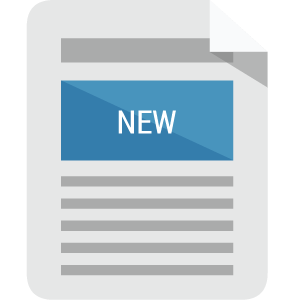
Key to the use of SpaceClaim for most people is the ability to import and export files of 3D models in all the major CAD formats, including neutral file formats. STEP is probably the most popular neutral file format amongst SpaceClaim users. If you work with STEP a lot, you’ll know that STEP has published a new standard called STEP AP242 and it’s starting to gain adoption. The new version supports STEP files AP242 as well as import graphical PMI for dimensioning and tolerancing for part manufacturing information.
The latest version of SpaceClaim 2017 can now open and import the following file formats:
- Inventor 2017
- NX 11
- Solid Edge ST9
- SOLIDWORKS 2017
For a complete list of files that SpaceClaim is compatible with for importing and exporting, please read SpaceClaim’s File Compatibility Document.

We’ve only highlighted some of the new features and enhancements to this year’s SpaceClaim CAD modeling software. To learn more about SpaceClaim 2017, including the latest SpaceClaim 2017.1 release that just came out in May, you can view the webinars using the link below: